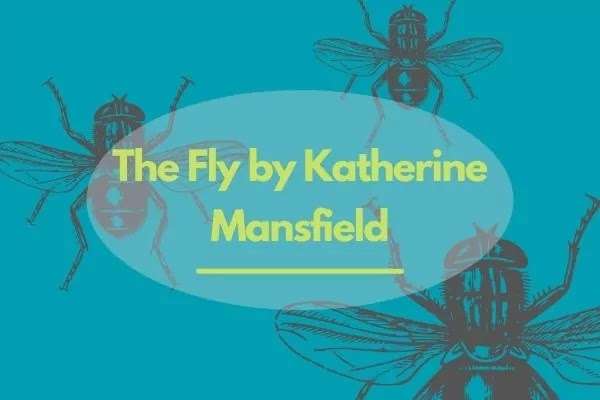The Fly by Katherine Mansfield
About the Author
Katherine Mansfield(October 14, 1888- Januarary09, 1923) is the pen name of a venerated short story writer, Katherine Mansfield Beauchamp Murry. She belonged to a well-heeled family settled in Wellington. She is a leading figure of the modernist movement in literature that began at the turn of the 20th century.
She had been an expatriate from colonized New Zealand who moved t United Kingdom during her teenage She became acquainted with D.H. Lawrence and Virginia Woolf there. She had penned down some of the finest short stories during her short literary career.
Her short stories mainly focused upon the social differences, class distinction, social injustice, childhood innocence, nostalgic strain, etc. Mansfield had contributed to a number of volumes of short stories and she touched the most sensitive aspects of human psychology in her short stories including Miss Brill, The Doll’s house, Prelude, Psychology, and The Fly.
All these shot stories give an elaborate overview of human existence and psychology. She could not enjoy a long-lasting professional success because in her late 20’s. She was diagnosed with tuberculosis which led her to her early death at 34.
Summary | The Fly
The Fly is a symbolic story. The writer has used fly as a symbol of human beings. She describes the idea that there is no escape from death. When death comes, no man can change his destiny. But time is a great healer. It powerfully affects human beings.
Time provides solace to the victims. All human beings are insignificant in the hands of fate as the fly was helpless in front of the Boss. In our life, we face many difficulties and hardships as the fly suffered in the story. We continue fighting against the hurdles till the last moment of death.
Katherine Mansfield also died at the age of 35 because of T.B. So she herself was fly in the story. In the story, the fly could not save her life from the Boss as Katherine herself could not save herself from the cruel Nature.
It is an old saying that time is the greatest healer of wounds and sorrows. Human beings cry over their misfortunes. They shed tears for some time. By and by they resume their normal activities. Time brings consolation and peace to their broken hearts.
The short story, The Fly by Katherine Mansfield takes place in an Office in England during First World War. In this story, we see two different characters both dealing with problems. Mr. Woodifield comes to see his ex-boss. He is retired and is a heart patient.
He admires the furniture and the new setting of the office. Then the boss offers him whisky. After drinking it, Mr. Woodifiled remembers what he has forgotten. He informs the boss that his daughters have gone to the graves of the boss’s as well as Mr. Woodifiel’s son. Actually, they have died in a war.
After Mr. Woodifield’s departure, the boss recalls his dead son. He tries to have the same feelings of sadness as he felt on the day of his son’s death. However, he fails. For the last try, he decides to go to the photograph of his son, but a fly in the inkpot attracts his attention. He forgets all about his son. He draws the fly out of the inkpot and puts the fly on a blotting paper.
As soon as the fly tries to fly, he sprinkles a drop of ink on it and enjoys its struggle to survive. Finally, the fly dies when drops of ink were poured on it. The boss throws it away and orders a fresh blotting paper. Then he tries to remember what he was thinking before attending the fly. It means he forgets his dead son again.
Important Questions and their Answers
Question 1
What is the theme or moral lesson of the story?
This story shows that everybody is a fly in the hands of fate.
Answer
It is a symbolic story presenting a tragic view of human life. The author has painted a disappointing picture of life by making use of certain symbols. Her purpose is to reveal the reality of human destiny. Old Woodifield was a friend of the boss. He came into the office of the boss and told him about the graves of his and boss’s son in Belgium.
He did not want to make fresh the grief of the boss. The boss loved his son very much who was killed in the First World War. When Mr. Woodfield left the office, the boss became sad because the visit of Mr. Woodifeild brought him back to the old memories, the memories of his son.
He ordered his servant not to let anyone in the office and bent forward in his comfortable chair. Being alone, he covered his face with his two hands. He wanted to weep but could not. He was lost in the thoughts of his son. In his imagination, he saw the open grave of his son in which his son was lying in a uniform.
His son was very intelligent and handsome. he had great hopes for the future of his son. At the death of his son, he wept a lot and told everyone that time could not reduce his grief because he had labored a lot to train his son in business.
the main theme or moral of the story is There is no escape from death, every animate thing has to taste death, sooner or later. This story also shows that everybody is a fly in the hands of fate. No one can save himself or herself from the hands of it.
Question 2
How and why did the boss kill the fly?
There is no escape from death. Every living thing has to taste death sooner or later.
Answer
It is an old saying that time is a great healer of wounds and sorrows. Human beings cry over their misfortunes. They shed tears for some time. By and by they resume their normal activities. Time brings consolation and peace to their broken hearts. Mr. Woodifield was a retired old man.
One day, he called on his ex-boss. The son of Mr. Woodifield and the boss were killed fighting in the Ist World War. He told the boss that last week his daughters visited the graves. He also told the boss that the graves were being well looked after.
After some time, Woodifiled left the office and went to his home. The boss was lost in his grief. he bent forward on his comfortable chair and covered his face with his hands. He wanted to weep but could not. He stood up from his chair. He wanted to do something. he was lost in the thoughts of his son.
At that time, a fly dropped into his inkpot. The fly tried a lot to come out of it but could not. The boss took out his pen and picked the fly out of the inkpot. He kept it on the blotting paper. It laid there for some time. After some time, it spread its wings and was ready to fly. Suddenly, there came an idea in the mind of the boss.
he put a heavy drop of ink on the fly. The fly tried its best to clean itself. The boss again put his pen into the inkpot and poured a drop of ink on the fly which was about to fly. The fly drowned in the heavy drop of the ink. He repeated this action five times, the fly died. He lifted the dead fly and threw it into the dustbin.
After reading the story, we can say that time has the healing hand. It dries the tearful eyes and gives solace to the perturbed soul. When some calamity befalls, man feels grieved and thinks that his grief will never come to an end. But with the passage of time, the intensity of pain and sorrow subsides and man finds a renewed vigor in him.
Question 3
The Fly is a story about the conquest of time over grief. Discuss.
Answer
Time is, in fact, always a blessing in disguise. that assists greatly in healing the deep wounds and scars on the soul of the man. As such, time is a great healer and it permanently and invariably goes on flowing. If there would have been no existence of time, i.e of the changes in the events in the universe, the wounds and scars would have continued bleeding and ever-growing painfulness.
In this perspective, life on the earth would have been a picture of the most miserable plight ever to be perceived. The constancy and performance of the flowing and rolling down of times has enabled the animate beings to go down the full and permitted tenure of life in a normal manner.
It substantiates our faith in our Creator and it is a part of our faith that death is inevitable. This is an inescapable and formidable reality that every living being has to taste, accept and tolerate. The fathomless time enables us the weaklings on the earth to forgot our old wounds and scars on our souls.
Old Woodifield was a friend of the boss. He came into the office and told him about the graves of his and boss’s son in Belgium. He did not want to make fresh the grief of the boss. The boss loved his son very much who was killed in First World War.
When Mr. Woodifield left the office, the boss became sad because the visit of Mr. Woodifield brought him back to the old memories, the memories of his son. He ordered his servant not to let anyone in the office and bend forward in his comfortable chair. Being alone, he covered his face with his two hands.
He wanted to weep but could not. He was lost in the thoughts of his son. Firstly, the story does not show any single word of grief spoken by Woodifield in the remembrance of Raggie, his only son who died perhaps six years ago. Secondly, Woodifield himself did not go to Belgium to visit his son’s grave and instead sent his daughters there.
Thirdly, by saying that his daughters had a look at poor Raggie’s grave, it means that even his daughters visited the graves merely as a picnic spot without shedding any tear for two dead youths. Fourthly, the boss could not go there during these six years to his son’s grave.
Fifthly, Woodifield’s talk reminds the boss of his dead son but soon he kills a fly and again becomes as much forgetful of his son as before. These five points prove that this story portrays the conquest of time over grief. In the end, we can say that with the passage of time, we forget our misfortunes that look deadly at first.



Thanks mam g 😘😘
This comment has been removed by a blog administrator.